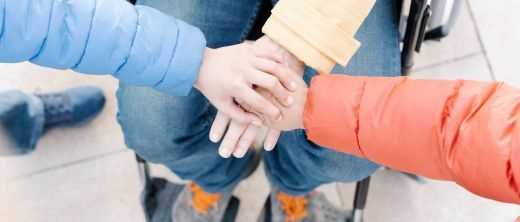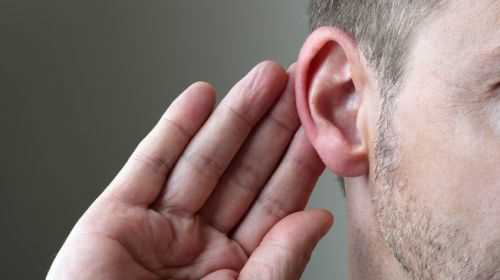Spinal muscular atrophy is a hereditary disease that causes so-called motor neurons to decay. The consequences of the nerve disease can include muscle wasting or paralysis. There are now drugs on the market that can increase life expectancy. Which therapies are still important and more about the cause and symptoms.
Spinal muscular atrophy (SMA) affects around one in 10,000 newborns. The nerve disease can make itself felt at any age, but is usually recognized in infancy. Sensory perception and intellect do not show any changes in people with spinal muscular atrophy.
Overview:
What is spinal muscular atrophy?
Spinal muscular atrophy results in defective motor neurons in the spinal cord over time. Motor neurons are important in controlling voluntary movements such as crawling or running. They pass on impulses to the muscle, which then converts them into motion. Proximal SMA is present in around 80 to 90 percent of those affected. It is characterized by a genetic defect on chromosome q5. A mutation of the SMN1 gene (survival motor neuron) leads to a lack of production of the SMN protein, which is essential for the maintenance of the motor nerves.
In order for the disease to break out in a person, a defective copy must be inherited from one parent. Spinal muscular atrophy is therefore an autosomal recessive inheritance. SMA usually begins with weakness in the proximal muscles such as the thighs and hips and is divided into four types (SMA types 1 to 4).
Symptoms of spinal muscular atrophy
The main sign of spinal muscular atrophy is generally weak muscles. The lack of impulses from the motor neuron virtually leads to a standstill of the muscle cells. As a result, the following symptoms of spinal muscular atrophy are possible:
- Muscle wasting (muscle atrophy)
- Paralysis
- decreased muscle tension (hypotonia)
Sensory perceptions such as sight, hearing or feeling as well as the intellect are not affected by the SMA. Depending on the type of course, other different symptoms of spinal muscular atrophy can occur:
Spinal muscular atrophy type 1: This variant of the disease is also known as Werdnig-Hoffmann disease or juvenile SMA. It begins in the first six months of life, but is usually recognized before the third month of life. Infants with type 1 spinal muscular atrophy are unable to lift their head or sit. They find it difficult to swallow from a certain point. The intercostal muscles may also be affected, which can make the chest appear sunken. This is due to the fact that only the diaphragm takes over the breathing process.
Spinal muscular atrophy type 2: Doctors usually diagnose spinal muscular atrophy of type 2 or chronic infantile SMA before the age of 18 months. Affected children can sit and sometimes stand with help, but are not able to walk. Swallowing problems usually do not occur. People may need help with feeding through a feeding tube. In addition, slight tremors in the outstretched fingers, difficulty coughing up, and breathing at night can be symptoms of spinal muscular atrophy. Scoliosis very often develops during growth. A reduced bone density is also possible.
Spinal muscular atrophy type 3: Kugelberg-Welander disease or juvenile SMA can become evident before (type 3a) or after (type 3b) the age of three. Children with the condition are often able to walk but may need assistance. Life expectancy is hardly reduced. A slight tremor of the outstretched fingers is also possible. Difficulty eating or swallowing is very rare.
Spinal muscular atrophy type 4: Adult SMA begins in adulthood. The course of the disease can be different for type 4, life expectancy is not affected. Breathing and swallowing muscles are rarely affected. Otherwise, the decrease in muscle function progresses slowly over the course of the disease.
People with spinal muscular atrophy either lose certain body functions very slowly or suddenly from another disease or a growth spurt. As you age, the likelihood that more and more muscles will be affected increases.
How is SMA diagnosed?
It has been known since December 2020 that newborn screening (NBS) for SMA will be introduced in Germany – this should be possible in mid-2021. The reimbursement of costs by the health insurance companies is also planned. All it takes is a drop of blood from the baby’s heel to test the blood in the laboratory for congenital metabolic and endocrine disorders. Spinal muscular atrophy can thus be detected early and treatment can be initiated.
Otherwise, an analysis for SMA can be carried out at any time by taking a blood sample. Specialized laboratories use molecular diagnostic methods to find out the absence of the SMN1 gene and can determine the number of SMN2 gene copies. These usually provide information about the severity of the disease. The SMN2 gene does not produce as much SMN protein as the SMN1 gene, but it can compensate for the deficiency caused by the genetic defect. The more copies of the SMN2 gene there are, the more SMN protein is available to the body and the decay of the motor neurons occurs more slowly.
The doctor will decide whether an examination for spinal muscular atrophy is necessary. For this purpose, various details are discussed in the anamnesis interview. What are the symptoms and how long have they been there? Are there any hereditary diseases in the family? When did physical changes first occur? These and similar questions need to be clarified in advance.
Therapy for spinal muscular atrophy
Spinal muscular atrophy can develop differently in those affected. For this reason, it is important to include various specialist areas in the treatment of the disease. Which interdisciplinary team is involved in the therapy depends on the symptoms or impaired organs and functions. The following departments can support:
- Respiratory care
- Gastroenterology and dietetics
- Orthopedics
- Physiotherapy and occupational therapy
- genetic counseling
Specialized neuromuscular clinics should be the first point of contact after the diagnosis of SMA. Contact with self-help groups and patient organizations is also helpful.
Medication for SMA
Several drugs are now on the market for the treatment of spinal muscular atrophy. Whether the preparations can be used depends on the severity and genetics of the disease. Since 2017 there has been a drug that can be used in SMA with changes on chromosome q5. It influences the existing SMN2 gene sequences, which thereby produce more functional SMN protein. The drug must be injected regularly through a lumbar puncture into the lumbar canal at the level of the lumbar spine.
Another SMA drug can be administered intravenously, but is dependent on body weight and is only used up to about 14 kilograms. In general, the effect is best before the first symptoms appear. At this point in time, no motor neurons are usually damaged. According to the current state of research, already defective nerve cells are probably not curable.
Physiotherapy and rehabilitation
People with spinal muscular atrophy often suffer from stiff joints, which can cause pain and restricted mobility. Individual improvement should be achieved through stretching, special exercises and aids such as supporting apparatus. Relatives also learn how to position the sick person correctly and how to best organize everyday life.
Orthopedic care
Weakened muscles in the area of the spine usually lead to a curvature of the spine (scoliosis or kyphosis) in spinal muscular atrophy without support. It is estimated that 60 to 90 percent of those who cannot sit and sit (but cannot walk) develop a curvature of the spine. This is also the case for around 50 percent of those affected who are able to walk. To avoid this, orthotics that support the trunk are often used. If the curvature is very advanced, surgery to straighten the spine may be necessary.
Spinal muscular atrophy: course and life expectancy
Life expectancy in people with spinal muscular atrophy depends on the shape. Type 1 SMA is one of the most common genetic causes of death in infants. Affected people with SMA type 2 have a survival rate of over 90 percent after ten years. People with type 3 have almost no reduced life expectancy and those with type 4 have a normal life expectancy.
.


